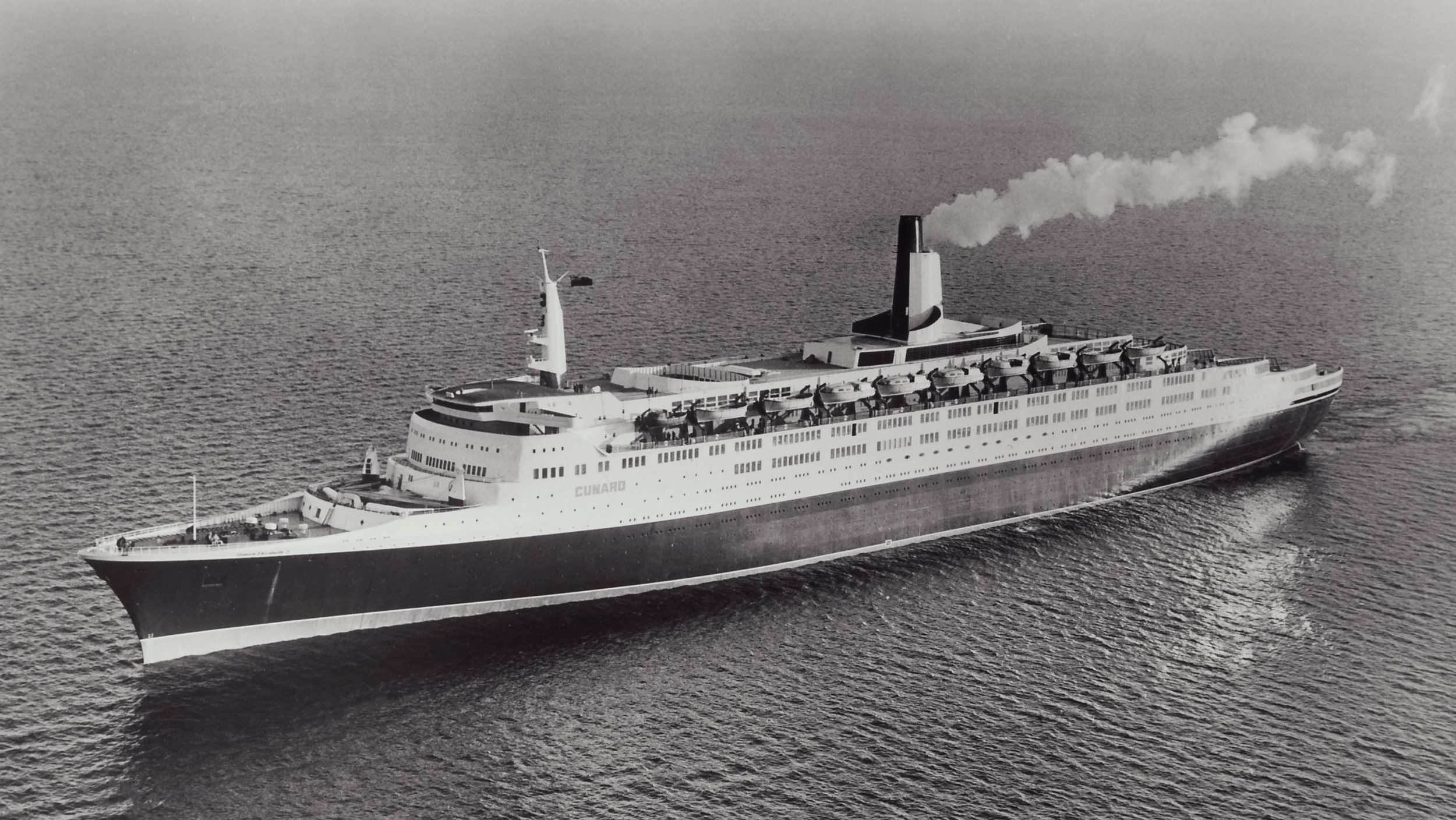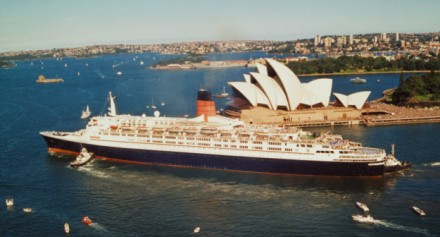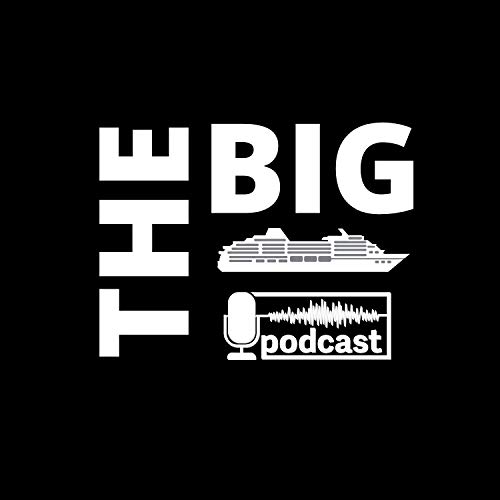QE2 History
A new Cunard liner

When the Boeing 707 entered commercial services on the North Atlantic in 1958, the era of the Ocean Liner entered uncertain times. Passengers flocked to the airliners which transported people faster, cheaper and in relatively high levels of comfort.
Initially, many shipping companies, including Cunard, were unfazed by this new threat. In fact, one Cunard director is famously quoted as saying “Flying is a Fad!” However nothing could stop the popularity of the jet, and as the Douglas DC8 and later the Boeing 747 entered service, passenger shipping all but collapsed.
At this time, Cunard was reliant on a large fleet of old ocean liners. Led by the venerable Queen Mary and Queen Elizabeth, the fleet was ill-placed to face the modern world.
To counter the threat of the jet, Cunard’s original idea was to build two new liners. The first of these was to be a 75,000 ton, three class vessel of similar dimensions to Queen Mary and Elizabeth. This design was code-named ‘Q3’ and as works progressed, the company decided that only one ship would be built – hopefully operating in tandem with the older Queen Elizabeth.
But the Q3 design was met by strong opposition; particularly from the British Government who Cunard were relying on to fund the new ship. Why would anyone want to travel across the Atlantic by ship, especially in tourist class, when they could do it by air for a lower fare?
The Q4 Project
Eventually, Cunard came to the realisation that Q3 was a white elephant, and abandoned the design. However amid this setback, the company started working on a new design, which became known as Q4.
Q4 was significantly different to Q3, and indeed any Cunarder before her. A dual purpose liner, this ship was small enough to transit the Panama Canal, allow her to undertake global cruising. The plan was met with much greater enthusiasm than Q3, which led to the British Government agreeing to provide a loan. However, the stakes were high – and Cunard had to mortgage 11 of their ships to help finance the project.
Cunard awarded the build contract to John Brown & Co. Scotland – the same yard that had built the Queen Mary, Queen Elizabeth and also the Aquitania and Lusitania. The keel laying ceremony belatedly took place on 5 July 1965, with the ship being allocated the designation of No. 736 – a name she was known by until the day of her launch.
Amid countless delays, construction slowly progressed at the Scottish shipyard. Launch dates were pushed back as industrial disputes and a skills shortage plagued the yard.
However, on 20 September 1967, H.M Queen Elizabeth II launched the ship. It was intended to name the ship Queen Elizabeth after the original Cunard Queen which was to be withdrawn before No. 736 entered service.
But Cunard and the assembled crowd of over 50,000 people were surprised when Her Majesty spoke the words “I name this ship Queen Elizabeth the Second”. After discussions with Buckingham Palace, Cunard adopted the arabic “2” for the ship, to help distinguish between the ship and the monarch. QE2 was born.
QE2’s fit-out process saw further delays, which pushed back her entry into service well into 1969. QE2 made her first voyage in November 1968 when she slowly sailed to dry-dock in Greenock in preparation for her sea trials. On this voyage, HRH. Prince Charles sailed aboard and sounded the ship’s whistle.
QE2 suffered further troubles with turbine issues delaying the acceptance of the ship. In fact, things got so tense that Cunard took the unprecedented move of formally refusing to accept the new ship until all defects had been rectified.
A triumph
QE2’s maiden transatlantic crossing set sail on 2 May 1969. She was well received by the American public, and became a profitable ship in her early years of service. During her first season, Cunard were able to repay £2.5 million of the Government loan. Her dual purpose design had allowed QE2 to thrive where her transatlantic counterparts could not.
In January 1971 while cruising in the Caribbean, QE2 received a distress call from the French liner Antilles. Antilles had run aground off the coast of Mustique in the Grenadines and caught fire. Being a fast ship in close proximity to the Antilles, QE2 went to her assistance.
However, by the time the QE2 arrived the passengers had been taken ashore. Antilles passengers and crew were brought aboard QE2 and taken to Barbados. As a testament to the quality of service offered aboard QE2, some of the Antille’s passengers booked subsequent cruises on the Cunarder.
In May 1972, while at sea during a transatlantic crossing, Captain William Law received notification that there was a bomb aboard QE2. Cunard took this threat very seriously and alerted the British Government who sent a bomb disposal unit out to the ship. Bomb disposal experts parachuted into the sea close to the ship and were brought aboard by QE2’s tenders. After a full sweep of the ship, the all clear was given as it turned out to be a hoax.
Later the FBI arrested the culprit for making similar threats against Pan American Airways. The bomb disposal teams were awarded the Queen’s Commendation for Brave Conduct.
As QE2’s cruising popularity increased and in response to the ongoing decline in shipping traffic on the North Atlantic, Cunard reduced the number of transatlantic crossings that QE2 took. The company maintained a strong summer presence on the Atlantic, however shifted the focus for the ship towards cruising. This saw QE2 undertake her first world cruise, an event that was well received – QE2 undertook a further 25 world cruises during her career.
Going to War
In 1982 the worsening situation in the Falklands Islands signalled a possibility that QE2 could see military service. When war broke out, QE2 was undertaking her usual schedule of cruises and transatlantic crossings. Initially she remained in civilian service, however the large P&O liner Canberra was called up for use as a troop ship making QE2’s involvement seem inevitable.
In May, QE2 was requisitioned by the government. Upon her return to Southampton, work began on a mammoth conversion that would see the addition of heli-decks to the ship. This involved significant structural works, including the cutting away of QE2’s aft decks. Major internal reconfiguration occurred to bolster the ship’s capacity, while military grade communications equipment installed in the ship.
QE2 embarked the 5th infantry brigade, comprising of the Scots and Welsh Guards and the Gurkhas, before setting sail for South Georgia on May 12th 1982. She arrived in the South Atlantic on 27 May, disembarking her troops in Cumberland Bay. These troops were transferred to Canberra for the last leg of the journey, while QE2 took onboard survivors from the HMS Ardent, Antelope and Coventry.
It was known that the Argentine airforce were searching for QE2, with a Boeing 707 chartered for air recognisance. As such, QE2 didn’t linger in the South Atlantic, and quickly headed north towards safety, having to refuel at sea on the way!
The ship returned to a triumphant welcome on 11 June 1982. She was met by the Royal Yacht Britannia. Aboard the Royal Yacht was HM. Queen Elizabeth, the Queen Mother, who sent a message to QE2, congratulating the ship’s 600-person volunteer crew for their brave exploits.
Following her wartime service, QE2 was given a significant refurbishment that took over two months. Undertaken at Southampton, the work included the restoration of QE2’s civilian interior; while alterations were made to the ship including the addition of a Golden Door Spa at Sea. The ship emerged with the traditional Cunard colours on her funnel, however controversially her hull had been painted in a light ‘pebble grey’ colour. This scheme proved very difficult to maintain and was quickly replaced with her traditional dark federal grey livery.
1986/87 Re-engine
QE2’s boilers and turbines had always been troublesome, with problems having developed during her sea trials. These issues plagued the ship in the early 1980s, and resulted in the cancellation of cruises which threatened to damage QE2’s reputation.
To address this issue once and for all, Cunard decided to re-engine the ship with a diesel electric power plant. The work, undertaken at the Lloyd Werft shipyard in Bremerhaven, Germany, were significant. It included the complete removal of her legacy steam turbine plant, with it being replaced by a new MAN B&W system. The work was expected to save Cunard £12 million a year in fuel, and critically would ensure QE2 remained reliable for the remainder of her career.
The new power-plant comprised of nine MAN B&W diesel electric engines. Each engine was nine cylinders. The plant came with two new propulsion motors, and new variable pitch propellers, while parts of the passenger accommodation was also modernised.
To allow for the work, QE2 was out of service from November 1986 to April 1987. The Cunarders Sagafjord and Vistafjord were used to cover QE2’s transatlantic schedule as well as world cruises.
Trials were conducted in the North Sea, where QE2 achieved a top speed of 34 knots – besting her steam turbine record. The ship returned to commercial service in April 1987. With new machinery, new interiors and an enlarged funnel, QE2 was refreshed and ready to face the next two decades of her service life.
Project Lifestyle

With the QE2’s engines upgraded and the ship’s mechanical future secured, Cunard’s attention turned to updating the ship’s interior.
A series of refits over the decades had led to QE2’s interior spaces becoming unquestionably mismatched. Elements of her radical original 1960s interior clashed with ad-hoc additions including an art deco Casino and 1980s style Grand Lounge.
Thus, in late 1994, under the direction of then-owner Trafalgar House Company, the QE2 was treated to a significant $45 million internal refurbishment, undertaken at the Blohm + Voss shipyard in Hamburg, Germany.
Dubbed “Project Lifestyle”, the refurbishment was the largest and most comprehensive redesign of the ship in her long history. Overseen by MET Studio, it covered the redesign and redecoration of almost all public spaces, including each passenger cabin and every bathroom aboard.
The ship’s livery was updated, with a new Royal Blue hull colour matched with a tricolour “speed stripe” which made up the new Cunard brand identity. A large gold lion rampant was added above the name Cunard to complete the transformation.
Sadly, insufficient time was given for the scale of the works, and QE2 sailed with workers still aboard. This led to significant negative press, which damaged the ship’s reputation.
However, by 1995 works were complete and as QE2 sailed on her “Golden Route World Cruise”, the magnificent new interiors were enjoyed by passengers around the world. By the time she returned to Southampton at the end of the voyage, her reputation was restored.
The late 90s
The QE2 undertook her 1000th voyage in 1995. To mark the occasion, the ship was greeted by a significant crowd in Southampton, while that same year the ship completed a circumnavigation of Britain. During this voyage, she made a historic call to Greenock; where she had been based during her sea trials. The ship also made a maiden call at Liverpool. This was the first visit to the historic maritime city by a Cunard Queen, and attracted over 1-million spectators.
Also during 1995 the QE2 encountered a rogue wave when sailing in the tail end of Hurricane Luis on the North Atlantic. The wave was estimated to be approx 90ft high and cleared the bridge! Captain Warwick described the wave as looking like the ‘White Cliffs of Dover’ coming towards the ship!
QE2 was treated to a further $18 million refit in 1996. Works were undertaken in Southampton’s King George V dry dock – the final time QE2 would use the facility before its closure. The refit concentrated on completing work outstanding from the 1994 refurbishment, as well as general touch ups. Externally, the removal of the Trafalgar House logo from the ship’s superstructure signalled the transfer of Cunard ownership from Trafalgar to Kværner.
The Carnival Years
The Kværner years were not easy for Cunard, with changes in the cruise line industry including the emergence of strong brands such as Carnival and Royal Caribbean which had significantly changed the market.
In April 1998, the industry was surprised when Carnival announced they had acquired Cunard for $800 million. QE2 was a significant part of this acquisition and Cunard were quick to announce they would spend a further $30 million on refurbishing the ship in preparation for the 21st Century. Vistafjord was also refurbished and emerged as Caronia, a smaller fleet mate to QE2.
QE2’s refit was completed at Lloyd Werft, Bremerhaven in Germany. The update focused on internal modifications that complemented the Project Lifestyle works; including new carpets, updated wall coverings, the creation of new suites aswell as the re-design of the Caronia Restaurant in a ‘Titanic-esque’ theme.
Externally, the ship was returned to traditional Cunard colours, which included a complete hull-strip and repaint. At the same time, Carnival announced “Project Queen Mary” – a transatlantic fleet mate for QE2. This resulted in the Queen Mary 2.
QE2 continued as Cunard’s lead transatlantic liner until 2004 when. Following a tandem crossing with the new QM2, the Boston Cup was symbolically transferred from QE2 to QM2, officially ending the QE2’s unprecedented reign as Cunard’s flagship. After a further internal refurbishment in Germany, QE2 returned to a full time cruising role, although she would undertake occasional transatlantic crossings as well as the annual World Cruise.
 The Final Years
The Final Years
In early 2007 QE2 and QM2 made a historic rendezvous in Sydney, Australia. This occasion took the city by surprise with an estimated crowd of close to 1 million turning out to witness the two ships together. 2007 also marked the 40th anniversary of QE2’s launch. A round Britain celebratory cruise commemorated the ship’s historic service-life.
However in June 2007, to the surprise of many, Cunard announced that QE2 was to be retired. For US$100 million, the most famous Ocean Liner of all time, had been sold. Her final destination was planned to be The Palm Jumeirah Islands, in Dubai, where it was expected she would be docked at a Marina and used as a international hotel and retail destination.
QE2 enjoyed a magnificent final season with Cunard. Her 2008 world cruise begun in January where she was joined by Queen Victoria on a tandem Atlantic crossing. The two liners met again in Fort Lauderdale and Sydney before all three Cunard Queens met for the final time in Southampton in April, 2008.
During her final World Cruise, QE2 visited New Zealand, Australia and Japan for the last time and crossed the equator for the final time. She also passed through the Panama Canal for the last time in her long service career.
QE2 departed Southampton for the final time on 11 November 2008. Her last voyage to Dubai was fully booked out and had sold out in a matter of minutes!
She sailed under the command of Captain Ian McNaught, arriving in Dubai on 26 November. The ship was handed over to her new owners the following day, ending her Cunard career.
QE2 Trails and Project Lifestyle Image: Michael Gallagher / Cunard.
QE2 Docked Image: Frame & Cross.


